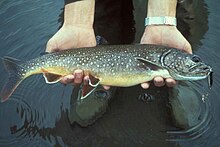American char
| American char | ||||||||||||
|---|---|---|---|---|---|---|---|---|---|---|---|---|

American char |
||||||||||||
| Systematics | ||||||||||||
|
||||||||||||
| Scientific name | ||||||||||||
| Salvelinus namaycush | ||||||||||||
| ( Walbaum , 1792) |
The American char ( Salvelinus namaycush ), also known as American lake trout , in Switzerland as Canadian lake trout , belongs to the salmon fish (Salmonidae).
features
It has the adipose fin between the dorsal and caudal fin , which is typical of salmon-like fish . The back color is black to dark brown, the sides are brown to dark gray and become light beige to dirty yellow towards the belly. Typical is a drawing on the sides with dirty white or yellowish dots. Depending on the body of water and the food available, the American Arctic char appears as streamlined or spindle-shaped, or, only with extremely large specimens, bulbous.
Weight
From the times of the lumberjacks in Canada 150 to 200 years ago, it is said that the American Arctic char was an important part of the diet and was easy to fish because of its abundance. There should have been specimens weighing up to 60 kg. A record specimen weighing 46 kg from Lake Athabasca is well documented. Because of the overfishing of North American trout waters by anglers, the weight of an American Arctic char is now one to three kilograms, but significantly higher in northern Canada and Alaska.
Occurrence
The American arctic char is native to deep, sufficiently cold, oxygen-rich lakes, more rarely in rivers in the northern half of North America . In the Great Lakes it has been almost wiped out due to overfishing, overfertilization and the increase in parasitic lamprey . Stable occurrences exist in suitable lakes in Ontario , Québec , Saskatchewans, and Manitobas, as well as in Alaska and the Northwest Territories .
Since the American Arctic char is very sensitive to changing environmental conditions and overfishing, complex procedures are used to maintain the native populations with farmed fish.
With varying success, the American Arctic char has also been used in waters and the like in the past two decades. a. South America , especially Argentina and Chile , exposed. He was in Europe in many mountain lakes in the Alpine region successfully settled.
Way of life
Compared to other fish, American arctic char becomes sexually mature late, which explains their sensitivity to environmental influences and overfishing. Depending on the type of water and the climate, as well as the associated food supply, they either develop into plankton eaters or predatory fish. The former grow very slowly and stay small, while the latter grow quickly and become large.
What both ways of life have in common is that in summer, the coolest and therefore deepest layers of water are sought. In winter, spring and late autumn, on the other hand, the American Arctic char can also be found on the surface of the water or under the ice cover and in shallow water.
Economical meaning
The American char is one of the most sought-after food fish in the New World. Depending on the food, it has white to slightly yellow, pale pink to intensely salmon-colored, dry and firm flesh and its taste can hardly be distinguished from salmon. These qualities decimated its occurrence considerably, so that the commercial fishery for the American char and the like. a. had to be abandoned at the Great Lakes.
fishing
The fishing for the American Arctic Char varies a lot with the seasons. In winter you can achieve good results with ice fishing close to the shore. In spring, after the snow and ice have melted, the American Arctic char stands close to the bank because of the cold water and can be caught by spinning or fly fishing . In summer, the American Arctic char lies lazily in the deep, cold water and can be persuaded to bite almost exclusively by trolling with heavy copper line, large spoons and baitfish impaled on it. In autumn, the fishing options from spring and summer mix, depending on the nature of the water and the water temperature.
literature
- David Stephen Lee et al .: Atlas of North American Freshwater Fishes . North Carolina State Museum of Natural History, Raleigh 1980, ISBN 0-917134-03-6 .
- Lawrence M. Page, Brooks M. Burr: Peterson Field Guide Series - A Field Guide to Freshwater Fishes: North America North of Mexico . Houghton Mifflin Company, Boston, New York 1991, ISBN 0-395-91091-9 .
Individual evidence
- ↑ a b Canadian lake trout from the Department of Economics of the Canton of Bern (accessed on April 22, 2013)
- ^ Fishing World Records
Web links
- Lake trout on Fishbase.org (English)
- IT IS
